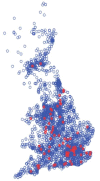Estimation of the number and demographics of companion dogs in the UK
- PMID: 22112367
- PMCID: PMC3305510
- DOI: 10.1186/1746-6148-7-74
Estimation of the number and demographics of companion dogs in the UK
Abstract
Background: Current estimates of the UK dog population vary, contain potential sources of bias and are based on expensive, large scale, public surveys. Here, we evaluate the potential of a variety of sources for estimation and monitoring of the companion dog population in the UK and associated demographic information. The sources considered were: a public survey; veterinary practices; pet insurance companies; micro-chip records; Kennel Club registrations; and the Pet Travel Scheme. The public survey and subpopulation estimates from veterinary practices, pet insurance companies and Kennel Club registrations, were combined to generate distinct estimates of the UK owned dog population using a Bayesian approach.
Results: We estimated there are 9.4 (95% CI: 8.1-11.5) million companion dogs in the UK according to the public survey alone, which is similar to other recent estimates. The population was judged to be over-estimated by combining the public and veterinary surveys (16.4, 95% CI: 12.5-21.5 million) and under-estimated by combining the public survey and insured dog numbers (4.8, 95% CI: 3.6-6.9 million). An estimate based on combining the public survey and Kennel Club registered dogs was 7.1 (95% CI: 4.5-12.9) million. Based on Bayesian estimations, 77 (95% CI: 62-92)% of the UK dog population were registered at a veterinary practice; 42 (95% CI: 29-55)% of dogs were insured; and 29 (95% CI: 17-43)% of dogs were Kennel Club registered. Breed demographics suggested the Labrador was consistently the most popular breed registered in micro-chip records, with the Kennel Club and with J. Sainsbury's PLC pet insurance. A comparison of the demographics between these sources suggested that popular working breeds were under-represented and certain toy, utility and miniature breeds were over- represented in the Kennel Club registrations. Density maps were produced from micro-chip records based on the geographical distribution of dogs.
Conclusions: A list containing the breed of each insured dog was provided by J. Sainsbury's PLC pet insurance without any accompanying information about the dog or owner.
Figures





References
-
- PFMA. How many dogs and cats are there in the UK? http://www.pfma.org.uk/statistics Accessed: 21/10/2010.
-
- Lund E, Armstrong P, Kirk C, Kolar L, Klausnor J. Health status and population characteristics of dogs and cats examined at private veterinary practices in the United States. J Am Vet Med Assoc. 1999;214:1336–1341. - PubMed
Publication types
MeSH terms
LinkOut - more resources
Full Text Sources

